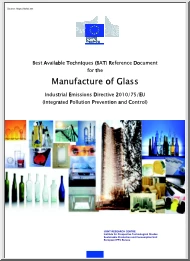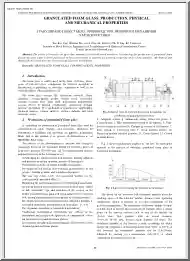No comments yet. You can be the first!
What did others read after this?
Content extract
BUILDING HISTORY The changing shape of window glass Fragile and costly window glass was introduced to New Zealand in the 1840s. Its often picturesque distortions or character has gradually given way to mass produced perfection. By Nigel Isaacs, BRANZ Principal Scientist E arly settlers brought window glass with them from Europe, protected from the rigours of sea transport by straw and crates. In April 1840, the New Zealand Gazette advertised the sale of ‘window glass’. It had arrived on the New Zealand Company’s ship Glenbervie, which docked safely in Wellington on 2 October 1839 after a 5-month journey from London. Included in her cargo were 78 boxes of glass and 24 pairs of windows. Cylinder glass came first Early window glass used in New Zealand was cylinder glass. A bulb of glass was formed by collecting a 25 lb (11 kg) blob of molten glass on the end of an iron blowpipe, where it was carefully blown into a ball. By simultaneously blowing and spinning it was expanded
into a flattened ball 12–18 inches (30–50 cm) in diameter. The bottom half was then drawn into a long cylinder by swinging it into a deep pit. Depending on the skill of the worker, a closed cylinder from 4 to 7 ft (1.2–21 m) long could be made. The cylinder was then cut off and, after a diamond score on the long side, it was placed in a heating oven where the glass split and flattened under its own weight. Finally it was placed in an annealing furnace where it was gradually cooled. The largest sheets were about 7 x 4 ft (2.1 x 1.2 m), but few workers were skilful enough to produce such large cylinders. Cylinder glass had many imperfections – waves that distorted the image and its reflection and flaws that speckled the glass. This was a result of variations in the raw materials and in the blowing. Internationally, the technology of window glass manufacturing improved, initially as 118 BUILD June/July 2007 a result of mechanising the cylinder glass process. By the 1920s the
Lubbers process (invented in 1896), which used compressed air and a mechanical puller, could produce a glass cylinder 30 ft (9.1 m) long and 30 inches (0.76 m) diameter But whether produced by hand or machine, a flattened glass cylinder would never be perfectly flat. Flat glass Blowing a glass cylinder around the early 1900s. Plate glass (thick sheet glass) was made by pouring molten glass onto a large flat iron table. At each end of the table, two strips of iron set the thickness and a large roller running on top of them formed the glass plate. Even with the best table and roller, plate glass had uneven, wavy faces and required grinding – an expensive process that removed more than a third of the thickness of the rough plate. A better, less expensive method was needed. In the mid to late 1800s, many schemes were patented to directly draw flat sheets. A solution was finally found in Belgium – a sheet could be drawn upward through a slit in a fireclay débiteuse (or vessel)
floating on top of the molten, viscous glass. After much experimentation and modification, Glass being drawn up at the Whangarei factory during the early 1960s. this came to be known as the Fourcault process. There were two major faults. First, the temperature of the drawing chamber was below the temperature of devitrification, allowing glass crystals to grow. These spoilt the glass surface, so the machine needed to be stopped every 7 or 8 days. Secondly, the fireclay slot gave ‘music lines’ which worsened as the slot wore. Such problems were solved using the new Pittsburgh Plate Glass (PPG) process. A ribbon of glass was drawn vertically upwards, directly from the molten glass. However, it tended to ‘waist’, making it impossible to maintain a constant width. This was solved by using aircooled, knurled rollers at the surface of the molten glass to cool the edges, making them rigid enough to resist ‘waisting’. 18 years of local production Until the late 1950s, New
Zealand’s growing glass market was serviced entirely by imports. In 1961, the McKendrick Glass Manufacturing Company Ltd was established. It built a major plant around a glass tank feeding two Fourcault machines, and started trials on 11 July 1962. However the plant did not produce acceptable quality window glass, and closed down later that year. In 1963, New Zealand Window Glass Ltd was formed as a partnership between Pilkington Brothers (New Zealand) Ltd and Australian Consolidated Industries Ltd. They changed to the PPG method, and in April 1964 commercial production began. Some 30,000 tonnes of glass were produced each year, ranging in thicknesses from 2 to 6 mm. The factory was sited in Whangarei for a variety of reasons, most significantly the cheap land and finance for buildings provided by the Whangarei Harbour Board. Other factors included the proximity to sand (the major raw material) and to the Auckland market; Whangarei’s stable labour force; plus good availability of
road, rail and sea transport. The raw materials came to Whangarei from around the world, the bulkiest from nearby. The annual totals for 1987 were: ❚ 24,000 tonnes of silica sand from Parengarenga ❚ 6,000 tonnes of dolomite from Golden Bay ❚ 6,000 tonnes of soda ash from USA ❚ 500 tonnes of sodium sulphate from USA or Chile ❚ 500 tonnes of limestone from Te Kuiti ❚ 200 tonnes of feldspar from Norway or Canada ❚ 20 tonnes of coal dust from Australia. By 1988, the plant employed 215 people and had eight salespeople based in Auckland. It produced about 600 tonnes (80,000 m2) of glass per week and exported 40% of its production to Australia, Japan and the Pacific. Glass was supplied in four grades – horticultural, standard, selected and special selected – and as quality increased, so did the price. Regular maintenance ensured the plant and tank operated correctly, but about every 6 years a full rebuild of the glass tank was required. The plant shut down, the tank was
emptied and old bricks which had withstood the 1600°C tank temperature were replaced. After the 4-week shutdown, bringing the tank back up to temperature took 3 weeks. The price of raw materials was important, as were energy costs. Initially energy costs were so low that wastage wasn’t a problem. The 1981 rebuild also saw a significant investment in thermal insulation. By 1983, natural gas had replaced oil – halving the fuel bill as well as providing a cleaner fuel (and bringing the pipeline to Whangarei for the rest of the community). Float glass revolution The seed of the Whangarei plant’s demise was being sown even as planning for the plant started. The float glass process, patent ed by Pilkington Brothers PLC in 1959, revolutionised the manufacture of window glass. Float plants can operate non-stop for between 10 and 15 years, producing flat glass in thicknesses from 0.4 to 25 mm and in widths up to 3 m. The float process has been licensed to more than 40 manufacturers in
30 countries and there are now 345 float plants in operation, construction or planning around the world. Together they produce 890,000 tonnes of glass a week. The first float plant in the Southern Hemisphere was opened in Dandenong, Victoria in 1974, pro ducing up to 6,000 tonnes a week – 10 times as much as the Whangarei plant at its peak. Glass production stopped at New Zealand Window Glass on 14 February 1991, and the tank was slowly cooled down. By April the glass was cool enough to be chipped out with pneumatic hammers, and newspaper advertisements announced its sale for ‘gardens, ornaments, paperweights, mementos’ at $1 per kg. The machinery was sold to Gunge Glass of Pakistan. So after 18 years of New Zealand production, window glass once again needed to be imported. Build’s ‘Building history’ is now a radio series. During June it will be on Radio New Zealand National’s ‘Sounds historical’ (Sunday from 8 to 10 pm). BUILD June/July 2007 119
into a flattened ball 12–18 inches (30–50 cm) in diameter. The bottom half was then drawn into a long cylinder by swinging it into a deep pit. Depending on the skill of the worker, a closed cylinder from 4 to 7 ft (1.2–21 m) long could be made. The cylinder was then cut off and, after a diamond score on the long side, it was placed in a heating oven where the glass split and flattened under its own weight. Finally it was placed in an annealing furnace where it was gradually cooled. The largest sheets were about 7 x 4 ft (2.1 x 1.2 m), but few workers were skilful enough to produce such large cylinders. Cylinder glass had many imperfections – waves that distorted the image and its reflection and flaws that speckled the glass. This was a result of variations in the raw materials and in the blowing. Internationally, the technology of window glass manufacturing improved, initially as 118 BUILD June/July 2007 a result of mechanising the cylinder glass process. By the 1920s the
Lubbers process (invented in 1896), which used compressed air and a mechanical puller, could produce a glass cylinder 30 ft (9.1 m) long and 30 inches (0.76 m) diameter But whether produced by hand or machine, a flattened glass cylinder would never be perfectly flat. Flat glass Blowing a glass cylinder around the early 1900s. Plate glass (thick sheet glass) was made by pouring molten glass onto a large flat iron table. At each end of the table, two strips of iron set the thickness and a large roller running on top of them formed the glass plate. Even with the best table and roller, plate glass had uneven, wavy faces and required grinding – an expensive process that removed more than a third of the thickness of the rough plate. A better, less expensive method was needed. In the mid to late 1800s, many schemes were patented to directly draw flat sheets. A solution was finally found in Belgium – a sheet could be drawn upward through a slit in a fireclay débiteuse (or vessel)
floating on top of the molten, viscous glass. After much experimentation and modification, Glass being drawn up at the Whangarei factory during the early 1960s. this came to be known as the Fourcault process. There were two major faults. First, the temperature of the drawing chamber was below the temperature of devitrification, allowing glass crystals to grow. These spoilt the glass surface, so the machine needed to be stopped every 7 or 8 days. Secondly, the fireclay slot gave ‘music lines’ which worsened as the slot wore. Such problems were solved using the new Pittsburgh Plate Glass (PPG) process. A ribbon of glass was drawn vertically upwards, directly from the molten glass. However, it tended to ‘waist’, making it impossible to maintain a constant width. This was solved by using aircooled, knurled rollers at the surface of the molten glass to cool the edges, making them rigid enough to resist ‘waisting’. 18 years of local production Until the late 1950s, New
Zealand’s growing glass market was serviced entirely by imports. In 1961, the McKendrick Glass Manufacturing Company Ltd was established. It built a major plant around a glass tank feeding two Fourcault machines, and started trials on 11 July 1962. However the plant did not produce acceptable quality window glass, and closed down later that year. In 1963, New Zealand Window Glass Ltd was formed as a partnership between Pilkington Brothers (New Zealand) Ltd and Australian Consolidated Industries Ltd. They changed to the PPG method, and in April 1964 commercial production began. Some 30,000 tonnes of glass were produced each year, ranging in thicknesses from 2 to 6 mm. The factory was sited in Whangarei for a variety of reasons, most significantly the cheap land and finance for buildings provided by the Whangarei Harbour Board. Other factors included the proximity to sand (the major raw material) and to the Auckland market; Whangarei’s stable labour force; plus good availability of
road, rail and sea transport. The raw materials came to Whangarei from around the world, the bulkiest from nearby. The annual totals for 1987 were: ❚ 24,000 tonnes of silica sand from Parengarenga ❚ 6,000 tonnes of dolomite from Golden Bay ❚ 6,000 tonnes of soda ash from USA ❚ 500 tonnes of sodium sulphate from USA or Chile ❚ 500 tonnes of limestone from Te Kuiti ❚ 200 tonnes of feldspar from Norway or Canada ❚ 20 tonnes of coal dust from Australia. By 1988, the plant employed 215 people and had eight salespeople based in Auckland. It produced about 600 tonnes (80,000 m2) of glass per week and exported 40% of its production to Australia, Japan and the Pacific. Glass was supplied in four grades – horticultural, standard, selected and special selected – and as quality increased, so did the price. Regular maintenance ensured the plant and tank operated correctly, but about every 6 years a full rebuild of the glass tank was required. The plant shut down, the tank was
emptied and old bricks which had withstood the 1600°C tank temperature were replaced. After the 4-week shutdown, bringing the tank back up to temperature took 3 weeks. The price of raw materials was important, as were energy costs. Initially energy costs were so low that wastage wasn’t a problem. The 1981 rebuild also saw a significant investment in thermal insulation. By 1983, natural gas had replaced oil – halving the fuel bill as well as providing a cleaner fuel (and bringing the pipeline to Whangarei for the rest of the community). Float glass revolution The seed of the Whangarei plant’s demise was being sown even as planning for the plant started. The float glass process, patent ed by Pilkington Brothers PLC in 1959, revolutionised the manufacture of window glass. Float plants can operate non-stop for between 10 and 15 years, producing flat glass in thicknesses from 0.4 to 25 mm and in widths up to 3 m. The float process has been licensed to more than 40 manufacturers in
30 countries and there are now 345 float plants in operation, construction or planning around the world. Together they produce 890,000 tonnes of glass a week. The first float plant in the Southern Hemisphere was opened in Dandenong, Victoria in 1974, pro ducing up to 6,000 tonnes a week – 10 times as much as the Whangarei plant at its peak. Glass production stopped at New Zealand Window Glass on 14 February 1991, and the tank was slowly cooled down. By April the glass was cool enough to be chipped out with pneumatic hammers, and newspaper advertisements announced its sale for ‘gardens, ornaments, paperweights, mementos’ at $1 per kg. The machinery was sold to Gunge Glass of Pakistan. So after 18 years of New Zealand production, window glass once again needed to be imported. Build’s ‘Building history’ is now a radio series. During June it will be on Radio New Zealand National’s ‘Sounds historical’ (Sunday from 8 to 10 pm). BUILD June/July 2007 119




